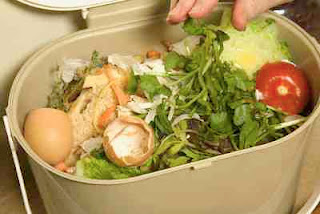Written and Photographed by Judith Sorgen
At a CNCH 2000 workshop, Stephenie Gaustad introduced her earthy,
homegrown flax and the long, abusive path the fibers endure to become
the luxury fabric we know as linen. Why would one venture on a journey
to cultivate and process such a labor intensive fiber? Perhaps it is
the romantic notion of the CNCH 2009 conference theme “From Hand to
Hand, Passing on our Fiber Tradition” or maybe a materialistic
opportunity to add more fiber processing tools to our stash.
The journey begins with the seeds both literally and figuratively.
Here, I have annotated the stepwise process with my experience growing
and processing flax.
Flax Fiber to Linen Thread
Cultivation – Seeds are planted in
spring; blue flowers appear 60 days after germination; flax is harvested
30 days after flowers are at their peak. My first plot was 4’ x 4’ and
thickly sown with seed from the health food store; the plants grew to a
height of 28” to 36”. The plants need a level growing area, sun and
consistent watering. It is best if the plants are protected from wind or
they may fall over The next year I purchased Linum Usitatissimum
‘Cascade’ (textile flax) seeds which grew to a maximum of 54” and had a
sturdier stem which I believe will be more easily processed.
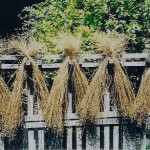
Dried Flax sheaves
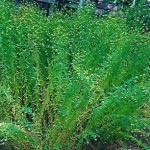
Flax Plot
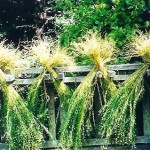
Flax sheaves
Harvest – Plants are pulled from the earth
to retain their roots. Flax stalks are aligned and placed in the sun to
dry. The bundles were tied in sheaves and arranged to dry in whatever
sun might shine in Mill Valley. It is important to maintain the
alignment of the stalks throughout the processing steps.
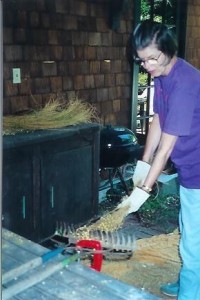
Rippling the Flax
Rippling – Seeds are removed by drawing
flax stalks through a hackle, an arrangement of spikes. The dryed stalks
were drawn through 2 rakes placed over a tarp to catch the seed pods
which could be used for another crop. The pods were crushed to release
the seeds which were passed through a sieve.
Retting – Flax stalks are ‘rotted’ by
placing on grass and allowing dew to provide the moisture for fungi and
molds to decompose the cortex and the stem walls or by allowing flax to
rest in slow moving water where bacteria and molds are the agents of
decomposition. In lieu of a lawn or a stream, my husband dug a pit and
lined it with plastic sheeting to create a retting pond. The flax
stalks were arranged in alternating layers; warm water was added; bricks
were placed on the flax to keep it submerged;
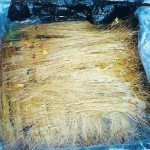
Flax in retting pond
black plastic was placed on top to absorb any heat that the Mill
Valley sun might supply; a screen covered the pond to discourage curious
raccoons; some water was siphoned out of the pond daily and refilled
with warm water. After about two weeks, the retting process seemed
complete; the test is that the pectin gluing the fibers inside the stem
has been dissolved and the 10- 12 flax fibers within the stem separate.
The yield at this point was 23 ounces. Note: The retting process can be
obnoxiously smelly so careful consideration of the placement of a
retting site is advised.
Breaking - Dried, retted flax is either
beaten with a corrugated mallet or placed in a hinged break to shatter
the outer stem so that the long flax fibers can be separated from the
waste, commonly called boon. My husband built
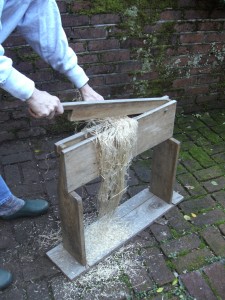
Breaking Flax
a break that worked well to crack the outer stem and the inner
cortex. A small bundle of stalks were placed on the break frame
starting in the middle; the brake handle is smartly lowered which cracks
the stem and cortex; the bundle is then moved along the break to expose
a new section of stems and the “breaking” process is repeated.
Scutching – The ‘broken’ boon is next
separated from the flax fibers by scraping a wooden scutching knife
along the fibers to push away the short pieces of stem. I used a
scutching knife made by Alden Amos and a scutching post made by my
husband to scrape away the boon. A bundle of flax stalks that had been
processed by the break was placed in the “V” of the scutching post and
the wooden scutching
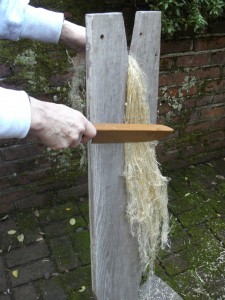
Scutching Flax
knife was drawn down along the fibers to dislodge and scrape away the
unwanted boon. My boon was very stubborn and not easily removed making
this step very difficult, slow and frustrating. My enthusiasm for
scutching waned at this point, although I was very pleased and excited
to see the “flaxen” fibers for the first time during this long process.
With persistence, I did scutch enough fiber to continue through the
remaining steps.
Hackling -Flax fibers are drawn through
rows of sharp spikes to separate the short fibers, tow flax, from the
longer, more desirable fibers, line flax. Alden’s hackle is a
veritable, medieval torture-chamber implement that effectively separates
the flax fibers into long silky strands. It must be treated with
respect and with a nearby supply of Band Aids. The hackle is clamped
to a sturdy table; a small bundle of scutched fiber is flicked onto the
hackle beginning with the tip ends; then it is drawn through the hackle;
the process is repeated moving up the bundle toward the root end.
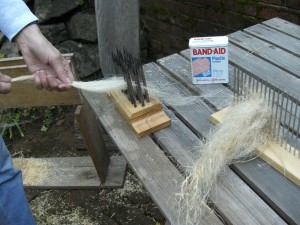
Hackling Flax
The bundle can then be reversed to hackle the root end portion. Tow
fibers will collect in the hackle and must occasionally be cautiously
removed. As much as half of the scutched fiber can be lost at this
stage; however, the tow flax can be spun into a coarse yarn or simply
composted. When several bundles have been hackled they are carefully
grouped into a strick making certain that the fibers are properly
aligned, that is, all of the root ends are together. This is line flax.
Spinning - Flax is spun ‘wet’ to produce smooth, shiny
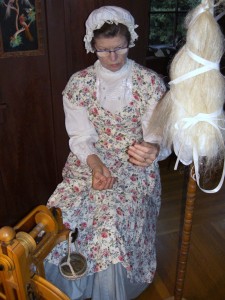
Spinning wet line flax
linen. Flax is generally spun fine. The strick was tied at the one
end and the fibers were fanned out. This arrangement was placed on an
upright distaff and a bowl of water was hung on the spinning wheel. As a
small group of fibers were drawn from the distaff by the drafting hand,
wet fingers of the other hand smoothed the newly formed linen thread.
Finishing – Linen threads are scoured in
washing soda and/or detergent to remove excess pectin and lignin. The
twist is set by drying as a skein or on a blocking reel. The linen
thread was wound on a perforated plastic cone. The cone was placed in a
solution of washing soda and boiled for 2 hours. The thread was then
wound into a skein to dry.
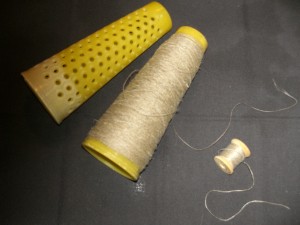
Spun linen thread
I’m now at the end of the “line”, so to speak, having been
disheartened by that stubborn boon, but I had fulfilled my goal of
growing, processing and spinning an ancient fiber. Yet, I did plant a
second crop which has been retted and rippled, so I am still engaged in
the process. Then a fifth grade teacher asked if I could help with the
harvest of the class’s flax crop and demonstrate processing the plant
into cloth. So I, in a colonial costume, loaded up my flax and
processing tools and went to the farm for the harvest. The teacher
wanted the children to know where clothing came from during the colonial
period, the amount of labor involved (including that of children) and
that textiles were “dear” rather than disposable. Their “That’s a lot
of work”, confirmed that they got his message and flax is just the fiber
to tell the story. The next year 3 classrooms of fifth graders used the
tools to experience flax processing from rippling to weaving; the big
hit was the menacing hackle.
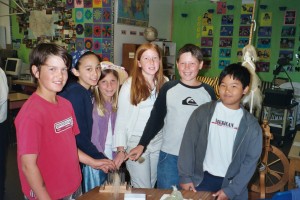
Students with hackle
In preparation for this project, I truly enjoyed researching the
history of flax and its contribution to various cultures down through
the ages. And yes, it is possible to take the flax journey vicariously
through reading, but it is much more rewarding to engage in the steps
yourself. As my hands transformed the flax from a resistant stalk into a
luxury fiber, I reflected upon our forebearers who toiled so hard and I
developed an immense appreciation for their persistence. Demonstrating
the flax process was a very rewarding means of sharing a textile
tradition with future generations. To those who endeavor to cultivate
and process flax, Alden Amos says, “Flax passes through several stages
of abuse before it becomes a useful textile fiber. Numerous rewards and
your personal sense of satisfaction will give a new meaning to smug.”
It has. Oh, did I mention all of the cool tools?
Suggested reading:
Linda Heinrich –
The Magic of Linen, Flax Seed to Woven Cloth
Alden Amos -
The Alden Amos Big Book of Spinning, illustrated by Stephenie Gaustad
Source for Seeds – Browse the Internet. Do not use perennial flax.
Source for Equipment
Alden Amos – : http://pweb.jps.net/~gaustad
source : http://www.cnch.org/cnchnet/spring-2011/flax-cultivation-whats-in-it/







